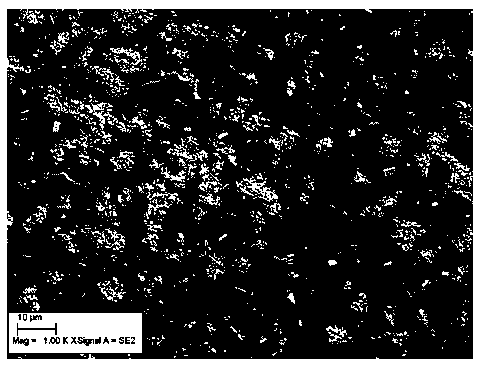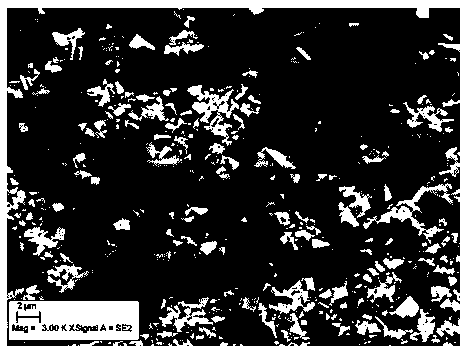Cemented carbide sintering method and sintered product under multi-atmosphere control
A technology of cemented carbide and sintering method, applied in metal material coating process, coating, solid-state diffusion coating, etc., can solve the problems of excessive carburization, difficult gas cracking degree, poor uniformity of solid-phase carburizing method of fillers, etc. , to achieve the effect of simplified processing steps, good product quality and good industrial application prospects
- Summary
- Abstract
- Description
- Claims
- Application Information
AI Technical Summary
Problems solved by technology
Method used
Image
Examples
Embodiment 1
[0024] Cemented carbide insert model CNMG120408, containing cubic carbide dopant (1% cubic carbide doping), containing 10% Co, 89%WC (0.8μmWC), first sintered at 1410°C in a traditional way, Cooled to room temperature under the protection of argon, the obtained product surface scanning photos are as follows: figure 1 shown by figure 1 It can be clearly seen that there are many cobalt areas on the surface of the product. The energy spectrum component analysis on the surface of the product is shown in Table 1. The cobalt content on the surface is 61.87%, which is much higher than the cobalt content of 10%, and a bonding phase is formed. thin layer of cobalt.
[0025] Table 1: Energy spectrum composition analysis of products obtained by traditional sintering methods
[0026]
[0027]The above-mentioned blades with the same composition and type are first heated to the eutectic temperature of 1350°C for heat preservation by the sintering method of the present invention, then h...
Embodiment 2
[0030] Carbide insert model SNMN150408, containing dopants (0.5% cubic carbide doping), 6.0% Co, 93.5% WC (1.0 μm WC), sintered at 1450 °C in a conventional manner, under argon protection, Cool to room temperature. The obtained product surface scan photos are as follows: image 3 As shown, it can be clearly seen that there are many cobalt areas on the surface of the product. The energy spectrum composition analysis of the product surface is carried out. The composition is shown in Table 3. The surface cobalt content is 51.4%, which is much higher than the cobalt content of 10%. Binder phase Cobalt thin layer.
[0031] Table 3: Energy spectrum composition analysis of products obtained by traditional sintering methods
[0032]
[0033] Blades of the same composition and type are heated to the eutectic temperature of 1350°C in the present invention, then heated to the sintering temperature of 1450°C, and then cooled to 1200°C. After the eutectic temperature of 1350°C, the pr...
Embodiment 3
[0036] An alloy containing 7.5% Co, 87.5% WC, and 5% dopant (5.0 μm WC, 5% cubic carbide doped), sintered according to the normal process, cooled to room temperature under the protection of argon, the product is carbon-poor, and characterized The performance index of alloy carbon content - cobalt magnetism is below the lower control limit. In order to solve the problem of decarbonization (low) of the product, the controllable atmosphere cemented carbide sintering method of the present invention is used to carburize the cemented carbide product of the above-mentioned embodiment, and the sintered alloy is heated to the eutectic temperature of 1350°C Keep it warm, then heat it to the sintering temperature of 1410°C and keep it warm, and then cool it to 1200°C. After holding the temperature from the eutectic temperature of 1350°C, start to introduce "carbon monoxide + hydrogen" with a pressure of 80mbar and a flow rate of 15slm. The flow rate of carbon monoxide is 5slm, CO :H 2 T...
PUM
| Property | Measurement | Unit |
|---|---|---|
| crystal size | aaaaa | aaaaa |
| crystal size | aaaaa | aaaaa |
Abstract
Description
Claims
Application Information
 Login to View More
Login to View More - R&D
- Intellectual Property
- Life Sciences
- Materials
- Tech Scout
- Unparalleled Data Quality
- Higher Quality Content
- 60% Fewer Hallucinations
Browse by: Latest US Patents, China's latest patents, Technical Efficacy Thesaurus, Application Domain, Technology Topic, Popular Technical Reports.
© 2025 PatSnap. All rights reserved.Legal|Privacy policy|Modern Slavery Act Transparency Statement|Sitemap|About US| Contact US: help@patsnap.com



